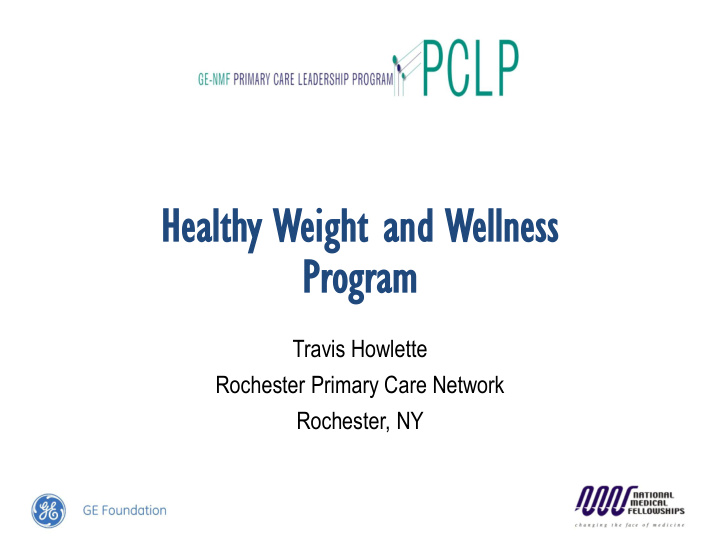



He Health althy y Wei eight ght an and d Wellness ellness Pr Program gram Travis Howlette Rochester Primary Care Network Rochester, NY
Introduction • Anthony L. Jordan Health Center’s Healthy Weight and Wellness Program (HWW) • Group medical visits with programming for patients to: • eat healthier, • improve their fitness, • lose weight, • and improve their energy and well-being overall • Assessments were conducted (screener and pre-survey) • Best practices were obtained throughout the process of enrollment and implementation
Background • Top 10 Most and Least Obese Major U.S. Communities
Background • In Rochester (Monroe County)… • 30% of adults in Rochester are obese and additionally 36% of adults are overweight. • Factors like location in the city (urban vs. suburban) and race have been shown to have great disparities • An estimated 33% of all deaths in Rochester are attributed to diet, physical activity and smoking • Roughly 20-30% of Monroe county residents consumes 1+ soda/sugar sweetened beverages, and consumes fruits and vegetables less than once a day • Additionally 16% report that they do not engage in any leisure- time physical activity in the past month.
Methodology • Group medical visits that meet once every other week over the course of 12 weeks (6 visits total) • Patient enrollment criteria: • Overweight or obese (BMI ≥25), • Aged 18 years or older, • Have at least 1-2 weight-related chronic condition(s) or symptom(s) (examples: diabetes, hypertension, dyspnea, sleep apnea, etc.), • English-speaking (not necessarily English as a native language), • Ambulatory, and • Current patients of the Anthony L. Jordan Health Center with some form of health insurance (either public or private).
Methodology • Enrollment included: • Phone and in-person recruitment • Administering an initial screener and a pre-survey • Pre- formed progress note templates within EHR’s • Feedback from program development team which led to the formation of suggestive practices for continuation and replication of the HWW program.
Results WEIGHT-RELATED CHRONIC DISEASE No Physical Activity Outside Daily Walking (without intent 55.45% to exercise)* Weight-Related Chronic Disease Percentage of Participants Most Common Motivation: Reduce Pain 18.18% Diabetes 36.36% Most Common Motivation: Family 27.27% Hypertension 90.91% Most Common Support: Family 54.55% Coronary Artery Disease 9.09% Most Common Support: Friends 36.36% Chronic Kidney Disease 0.00% Quality of Life is Fair or Below** 72.73% Obstructive Sleep Apnea 0.00% Depression 54.55% DIETARY HABITS Joint Pain 45.45% Food Consumption Average Hyperlipidemia 36.36% Meals/day 2 GERD 18.18% Vegetables/day 1.5 Other 54.55% Fruit/day 2 Fast food/week 2 SOCIAL/BEHAVIORAL FACTORS Social/Behavioral Factors BODY MASS INDEX (BMI) <4 hours of Sleep 30.00% BMI Percentage of Participants ≥7 hours of Sleep 40.00% BMI > 30 but <40 54.55% Smokers 9.09% BMI >40 45.45% Alcohol users 36.36% Other substance users 9.09% Average Concerning symptom: Weight 45.45% Average BMI of Participants 41.11 Most common barrier: Pain 27.27%
Discussion • Data provides the team with the upcoming challenges • Patients provided 14 topic areas they wish to have within the curriculum • 9 were already within the curriculum • The remaining 5 could be boiled to two additional topics: • Alternative medicine in regards to eating • Managing pain with food/exercise • Continued successful development of this program will be contingent upon the ability to adapt the curriculum according to the patient’s desires.
Recommendations: Enrollment • Use the variables in the screener to capture patient- driven topic areas for the curriculum • Start enrollment and screening/survey earlier • Have a member of the program development team be present at the clinics being used for recruitment • While conducting the screener and surveys discuss as a team how to ask and explain each question
Recommendations: Program Planning/Implementation • Develop a quick template within the electronic health records system • Make sure to load the template for each patient prior to the visit • Call patients during the off week to check-in and the day before to remind them of the visit • Look out for literacy issues • Prepare the program development team to be sensitive to group dynamics • Provide handouts that will capture chief complaint, goals, review of systems (ROS) and current medication list • Create a shared digital filing system for handouts
Conclusion • A lot of promise for the HWW program: • Financially sustainable • Great informal qualitative feedback from patients • Measures of retainment will be a litmus test of how the program is doing at keeping the patients involved • Limitations: • Only Anthony Jordan Health Center patients • Screeners/pre-surveys were administered in two different environments (i.e. phone or in-person) • Minor adaptations in the implementation of the program
Acknowledgements • Program Development Team:Lynn Moll, Melanie Murphy, Heather Muxworthy, Kara Fredette, Jamila Miller, Jennifer Carroll, Jalia Tucker • Anthony L. Jordan Health Center • GE National Medical Fellowships - Primary Care Leadership Program
References Spitzer, R.L, Kroenke, K. & Williams, J.B. et al. A brief measure for assessing generalised anxiety disorder: • the GAD-7. Arch. Intern. Med. 2006: 166:1092-7. Kroenke, K., Spitzer, R.L., Williams, J.B. et al; Anxiety disorders in primary care: Prevalence, impairment, • comorbidity, and detection. Ann Intern Med. 2007 Mar 6; 146(5):317-25 • Thorpe, K.E. The Future Costs of Obesity: National and State Estimates of the Impact of Obesity on Direct Health Care Expenses. National Collaborative of Childhood Obesity Research. Accessed July 3 rd 2014. http://www.nccor.org/downloads/CostofObesityReport-FINAL.pdf • University of Rochester Medical Center. Community Health Assessment and Community Health Improvement Plan: Monroe County, NY. University of Rochester Medical Center Resource. Accessed July 2 nd 2014. http://www2.monroecounty.gov/files/health/DataReports/Monroe%20County%20cha%20chip%202013.pdf • Ogden CL, Carroll MD, Kit BK, Flegal KM. Prevalence of obesity among adults: United States, 2011 – 2012. NCHS data brief, no 131. Hyattsville, MD: National Center for Health Statistics. 2013. Riffkin, R. Boulder, Colo., Residents Still Least Likely to Be Obese. Gallup Well-being Article (April 2014). • Accessed July 14, 2014. http://www.gallup.com/poll/168230/boulder-colo-residents-least-likely-obese.aspx McGinnis JM, Foege WH. Actual causes of death in the United States. JAMA. 1993 Nov 10;270(18):2207- • 12.
Recommend
More recommend